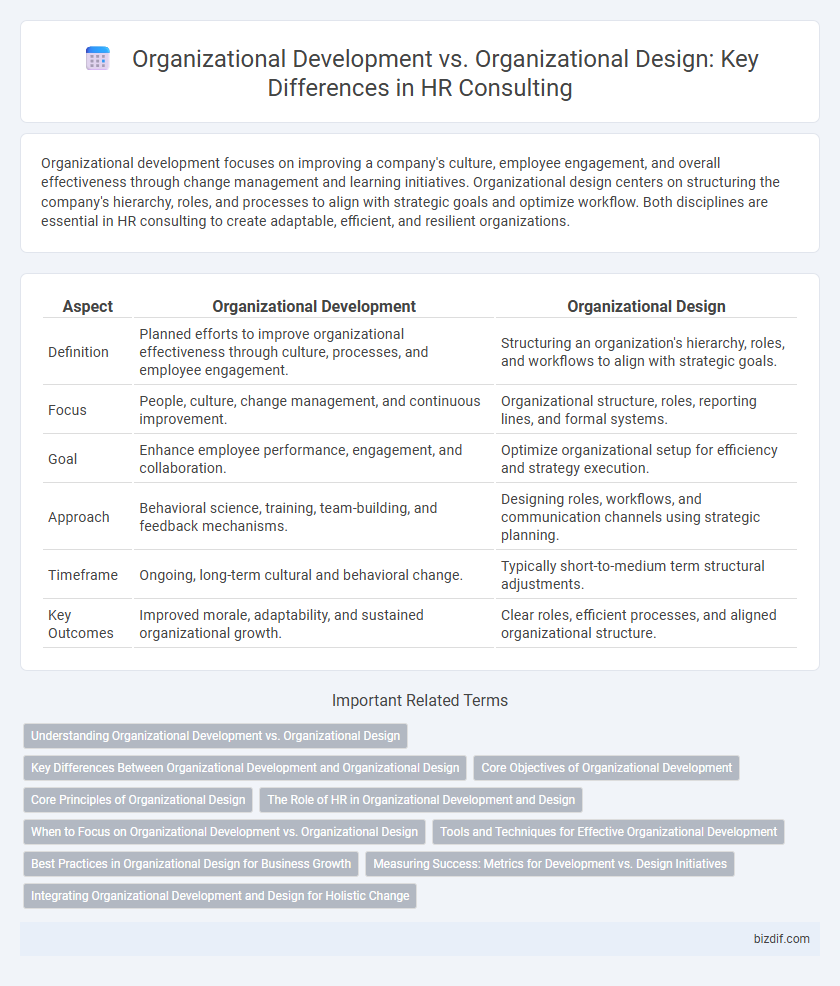Organizational development focuses on improving a company's culture, employee engagement, and overall effectiveness through change management and learning initiatives. Organizational design centers on structuring the company's hierarchy, roles, and processes to align with strategic goals and optimize workflow. Both disciplines are essential in HR consulting to create adaptable, efficient, and resilient organizations.
Table of Comparison
| Aspect | Organizational Development | Organizational Design |
|---|---|---|
| Definition | Planned efforts to improve organizational effectiveness through culture, processes, and employee engagement. | Structuring an organization's hierarchy, roles, and workflows to align with strategic goals. |
| Focus | People, culture, change management, and continuous improvement. | Organizational structure, roles, reporting lines, and formal systems. |
| Goal | Enhance employee performance, engagement, and collaboration. | Optimize organizational setup for efficiency and strategy execution. |
| Approach | Behavioral science, training, team-building, and feedback mechanisms. | Designing roles, workflows, and communication channels using strategic planning. |
| Timeframe | Ongoing, long-term cultural and behavioral change. | Typically short-to-medium term structural adjustments. |
| Key Outcomes | Improved morale, adaptability, and sustained organizational growth. | Clear roles, efficient processes, and aligned organizational structure. |
Understanding Organizational Development vs. Organizational Design
Organizational development focuses on enhancing a company's culture, employee engagement, and overall effectiveness through change management and learning initiatives. Organizational design involves structuring roles, responsibilities, and workflows to optimize efficiency and align with business goals. Understanding the distinction helps HR consultants tailor strategies that foster both human capital growth and operational optimization.
Key Differences Between Organizational Development and Organizational Design
Organizational development focuses on improving a company's culture, employee engagement, and overall performance through change management and training programs, emphasizing long-term growth and adaptability. Organizational design centers on structuring roles, workflows, and hierarchies to optimize efficiency and clarity in reporting relationships, aiming for immediate operational effectiveness. Key differences lie in organizational development's human-centric approach versus organizational design's emphasis on formal structure and systems within an enterprise.
Core Objectives of Organizational Development
Organizational development centers on enhancing company culture, improving employee engagement, and fostering continuous learning to drive long-term performance and adaptability. This process involves strategic interventions that boost collaboration, support change management, and develop leadership capabilities. Unlike organizational design, which structures roles and hierarchies, organizational development prioritizes evolving human capital and workplace dynamics to achieve sustainable growth.
Core Principles of Organizational Design
Organizational design centers on structuring roles, responsibilities, and workflows to create an efficient, scalable system that aligns with business strategy and enhances performance. Core principles of organizational design include clarity of purpose, streamlined communication channels, balanced spans of control, and adaptability to change. Organizational development focuses on human and cultural factors, but organizational design provides the foundational blueprint that drives operational effectiveness and strategic alignment in HR consulting.
The Role of HR in Organizational Development and Design
HR plays a pivotal role in organizational development by driving change management initiatives, enhancing employee engagement, and fostering leadership capabilities to support sustainable growth. In organizational design, HR strategically aligns structures, roles, and workflows to optimize efficiency and adapt to evolving business needs. Leveraging data analytics and workforce planning, HR ensures that development efforts and design modifications synergistically improve organizational performance and culture.
When to Focus on Organizational Development vs. Organizational Design
Focus on organizational development when aiming to improve employee skills, enhance culture, and foster long-term growth through continuous learning and change management. Prioritize organizational design during periods of structural change, such as mergers, expansions, or shifts in strategy, to realign roles, workflows, and hierarchies for optimal efficiency. Balancing these approaches ensures sustained performance by addressing both human dynamics and formal organizational architecture.
Tools and Techniques for Effective Organizational Development
Organizational development employs tools such as employee surveys, feedback loops, and team-building exercises to enhance communication, collaboration, and overall performance. Techniques like change management models, action research, and training programs systematically address cultural and behavioral shifts within the company. Organizational design focuses more on structural tools like workflow analysis, role clarification, and process mapping to optimize organizational architecture and resource allocation.
Best Practices in Organizational Design for Business Growth
Organizational design focuses on structuring roles, responsibilities, and processes to optimize workflow and efficiency, while organizational development emphasizes change management and culture enhancement for overall effectiveness. Best practices in organizational design for business growth include aligning structure with strategic goals, promoting cross-functional collaboration, and implementing scalable frameworks that adapt to market dynamics. Leveraging data-driven insights and employee feedback fosters agility and innovation, driving sustainable growth and competitive advantage.
Measuring Success: Metrics for Development vs. Design Initiatives
Measuring success in organizational development relies on metrics such as employee engagement scores, leadership effectiveness, and culture adaptability, reflecting long-term behavioral changes and workforce alignment. Organizational design success is gauged through structural efficiency indicators like process optimization, role clarity, and decision-making speed, emphasizing operational performance improvements. Combining these metrics provides a comprehensive view of both human-centric growth and structural efficacy in HR consulting initiatives.
Integrating Organizational Development and Design for Holistic Change
Integrating organizational development and design enhances holistic change by aligning structural frameworks with cultural and behavioral advancements. Organizational design focuses on creating effective structures, roles, and workflows, while organizational development targets employee engagement, skills, and change management. Combining these approaches drives sustainable transformation, improving agility, innovation, and overall organizational performance in dynamic business environments.
Organizational development vs organizational design Infographic

 bizdif.com
bizdif.com